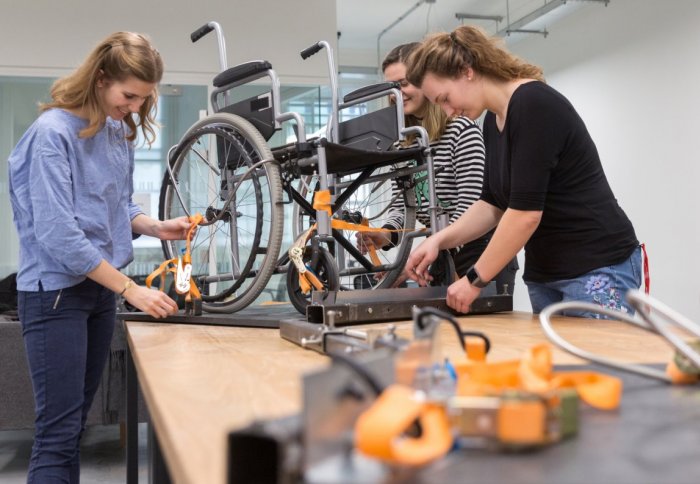Wheelchair Fencing innovation breaks down barriers to the sport

A team of Imperial undergraduates have created a new low-cost design for a Wheelchair Fencing frame to open up the sport to people worldwide.
Camille Morand-Duval (Mechanical Engineering), Josephine Latreille (Dyson School of Design Engineering) and Leah Pattinson (Dyson School of Design Engineering) worked with the International Wheelchair & Amputee Sports Federation (IWAS) on the project, which aimed to provide a more affordable alternative to elite-level equipment.
During Wheelchair Fencing, athletes’ wheelchairs have to be anchored to the ground with the use of a frame. However the cost of such equipment can be prohibitively high, creating barriers for many wishing to participate in the sport.
The team, supervised by Dr Ian Radcliffe from the Department of Bioengineering, received a grant from IWAS to create a design for a Wheelchair Fencing frame using inexpensive, readily available materials and which can be constructed using simple techniques.
They worked with GB's Dimitri Coutya, double Wheelchair Fencing World Champion, to test and refine their prototype frame.
Daoliang Hu (CHN) vs Dimitri Coutya (GBR)
The final design, and simple instructions on how to build it, have been made available free online by IWAS for clubs and athletes across the world to download and use.
Breaking barriers
Student designer Josephine said: “We believe that anyone who wants to participate in sport should have the opportunity to do so. But a lack of proper equipment can create obstacles.”
“Wheelchair fencing frames can cost thousands of pounds. This makes them out of the reach of many clubs, especially in developing countries.”
The team with Bob Paterson, Charmaine Hooper and Hilary Sahota (IWAS)
The team’s goal was to design a frame that could be replicated anywhere in the world by someone with only basic tools and no specialist knowledge.
Josephine said: “The design process involved a lot of hacking and experimenting. Wheelchair Fencing frames are generally made with bespoke parts and specialist manufacturing equipment. We had to try and find ways to simplify this.”
Fellow designer Camille added: “We used materials that are simple to get hold of, or which could be easily substituted for what people might have lying around – such as car parts.”
As part of their research, the team spoke to clubs in South Africa, India, and Uruguay to understand the needs of different individual athletes, clubs and coaches.
Following this feedback, the team opted for a modular design so that parts of the frame could be replaced, modified or upgraded where needed. They also made the frame as lightweight and compact as possible so it could be easily transported to competitions – an important consideration for clubs.
Designer Leah explained: “Everyone is different, and the frame had to be able to adapt to lots of different needs.”
IWAS CEO, Charmaine Hooper said, "The cost of a wheelchair fencing frame can often pose a challenge to athletes, clubs or coaches just getting into the sport. By delivering these free resources IWAS hopes to provide an alternative option that will help to eliminate this obstacle and make the sport more accessible for all."
Leah Pattison, Dr Ian Radcliffe, Camille Morand-Duval and Josephine Latreille
Photo credit (Photo 2 - Hu vs Coutya): Heather
Article text (excluding photos or graphics) available under an Attribution-NonCommercial-ShareAlike Creative Commons license.
Photos and graphics subject to third party copyright used with permission or © Imperial College London.